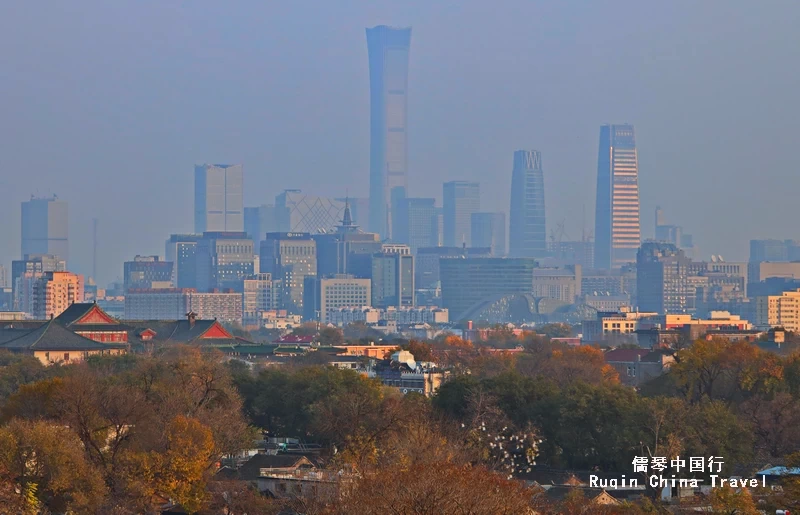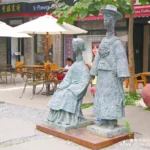The Drum Tower in Beijing is a must-visit landmark for anyone exploring the city’s rich history and culture. Located in the heart of the ancient capital, this towering structure offers a glimpse into Beijing’s past while providing stunning views of the surrounding area. In this guide, you’ll learn everything you need to know about how to visit Drum Tower in Beijing, including its history, what to see, practical tips, and nearby attractions.
A Brief History of the Drum Tower
The Drum Tower, or Gulou ( 鼓楼)in Chinese, was built during the Yuan Dynasty (1271–1368). It originally served as the city’s central timekeeping station. Drums were used to mark the time of day, an essential function before mechanical clocks became common.
During the Ming and Qing Dynasties, the Drum Tower continued to play a vital role in regulating daily life. Large drums inside the tower signaled the start of the day, noon, and night. The nearby Bell Tower complemented this function with its deep, resonant bell sounds. Today, the Drum and Bell Towers stand as symbols of Beijing’s rich cultural heritage.
Why Visit the Drum Tower?
Visiting the Drum Tower is more than just a sightseeing activity. It is an opportunity to connect with Beijing’s ancient traditions. The tower showcases beautiful architecture, offers panoramic views, and hosts daily drum performances.
👉Explore Our Curated Beijing Tours
Many tourists visit the Drum Tower as part of a broader Beijing cultural landmarks itinerary. Its central location makes it an excellent starting point for exploring nearby attractions, such as the Bell Tower, surrounding hutongs (traditional alleyways), and trendy cafés.
What to See at Drum Tower Beijing
Today, Drum Tower Beijing is a nationally protected cultural heritage site. The Drum Tower is a key part of Beijing’s central axis, blending ancient architectural beauty with modern elements to create a unique cultural experience.

The Drum Tower stands 46.7 meters tall and covers an area of approximately 7,000 square meters. Its double-eaved, wooden pavilion structure showcases classic ancient Chinese architecture.
Kind reminder: There are 69 steps to climb the Drum Tower in Beijing. No elevator to the second floor, so it is not wheelchair friendly.

Details About the Drum Tower’s Stairs
Stair Characteristics: The steps are steep and narrow, making the climb a bit challenging. It requires effort to ascend in one go.
Number of Steps: Inside the northeast corner of the Drum Tower, there is a small north-facing door leading to the upper level. The staircase consists of 69 stone steps.
The Drums
Inside, you’ll find 25 large drums that once kept time during the night. These drums sounded on the hour to remind people of the time. The tower also played an important role in imperial ceremonies, serving as a time-regulating hub for royal protocols.

The highlight of your visit will undoubtedly be the massive drums displayed on the second floor. Each drum is carefully restored to reflect its original grandeur. These instruments were used to mark time and warn the city of emergencies.
Drum Performances at Drum Tower
One of the most exciting aspects of visiting the Drum Tower is the traditional drum performance. Held several times daily, these shows feature skilled drummers recreating the rhythms of ancient Beijing.

The thunderous beats and coordinated movements create an unforgettable experience.
The Views from the Drum Tower
Reaching the top of the Drum Tower offers a stunning vantage point over Beijing.

From here, you can see the iconic Wanchun Pavilion perched on Jingshan Hill in Jingshan Park, a historic site once central to imperial life.

Still to the south on the central axis, the striking White Pagoda of Beihai Park stands out, symbolizing ancient Buddhist architecture.

Looking further to the east, the modern skyline comes into view, with towering structures like the China Zun skyscraper in Beijing’s CBD.

Closer to the tower, the Shichahai area unfolds in a panoramic display of lakes, hutongs, and bustling life. This unique blend of history and modernity is truly mesmerizing.
Best Time to Visit Drum Tower
The best time to visit the Drum Tower is in the morning or late afternoon. In the morning, you can enjoy fewer crowds and cooler weather. Late afternoons offer the added charm of golden sunlight, perfect for photography.

If you’re planning your Beijing cultural landmarks itinerary, consider visiting during spring or autumn. These seasons provide comfortable temperatures and clear skies. Avoid peak holidays like Chinese New Year or Golden Week, as the area can become very crowded.
Getting to Drum Tower Beijing
The Drum Tower is located in the bigger Shichahai Area in Dongcheng District, making it easily accessible from anywhere in Beijing. Here are some popular options for Beijing transportation to Drum Tower:

By Subway
Take Subway Line 6 or Line 8 to Nanluoguxiang Station. From there, it’s a short walk to the Drum Tower and Shichahai. Follow the signs, and you’ll find the tower easily.
By Taxi or Ride-Share
Taxis and ride-share apps like Didi are convenient for direct travel. Be sure to provide the Chinese name (Gǔlóu) 鼓楼 to the driver.
By Bicycle
For a more adventurous experience, rent a bicycle and explore the surrounding hutongs. Many tourists enjoy cycling as it offers a unique way to immerse yourself in local culture.
Tickets and Opening Hours
You can purchase tickets for both the Drum and Bell Towers at the entrance. A combined ticket usually costs around 30 RMB, making it an affordable activity; if you buy the tickets separately, each costs 20 RMB. If you’re visiting during peak times, arrive early to avoid long lines.

Remember, the ticket grants access to both towers, so make sure to visit the Bell Tower as well. Its massive bronze bell and impressive architecture are worth the short walk.
The Drum Tower is open daily from 9:00 AM to 5:00 PM. Last admission is typically at 4:30 PM, so plan accordingly.
Keep in mind that drum performances are scheduled at specific times, usually every hour. Check the schedule upon arrival to ensure you don’t miss the show.
👉Explore Our Curated Beijing Tours
Nearby Attractions and Food Recommendations
Beijing’s Drum Tower is surrounded by a variety of attractions and delicious food options, making it easy to plan a full day of exploration.
Nanluoguxiang
Nanluoguxiang is one of Beijing’s most popular and well-preserved hutongs. This lively area is perfect for walking and discovering traditional alleyways filled with boutique shops and local delicacies. You’ll find trendy cafés alongside small craft stores selling everything from handmade jewelry to vintage-style Beijing postcards. For a snack, don’t miss the creamy soufflés or snowflake crisps at Chuí Táng Bāng, both beloved by locals and visitors.
Shichahai
A short walk from the Drum Tower, Shichahai offers a picturesque escape with its series of lakes surrounded by willow trees and historic buildings. Take a leisurely stroll along the shores or rent a paddleboat for a unique view of the area. At sunset, the Golden Ding Bridge and Silver Ding Bridge are perfect spots for photographs, as they reflect beautifully on the water.

Prince Gong’s Mansion
This Qing Dynasty mansion, located near Shichahai, offers a peek into the luxurious life of Chinese nobility. Explore its elegant gardens, ancient halls, and intriguing exhibitions about royal culture.
Yandaixiejie
Known as “Pipe Alley,” Yandaixiejie exudes old Beijing charm with its narrow streets and unique blend of shops. Try popular street foods like candied hawthorn or grilled lamb skewers, and browse shops selling antiques and handmade crafts.

East Street (Dongdajie)
Foodies will love East Street for its abundance of snack shops. Xiān Dòu Guǒ Fū offers sweet and savory treats, while Bào Shī Fù is famous for its buttery pastries. This street is a hidden gem for sampling authentic Beijing flavors.
Each location adds a unique layer to your visit, ensuring a memorable day near the Drum Tower.
Practical Tips for Visiting the Drum Tower
To make the most of your visit to the Drum Tower, it’s essential to plan ahead. Start your trip early in the day to avoid the crowds, as the tower tends to get busier by late morning and afternoon. Arriving early allows you to fully enjoy the panoramic views from the top and watch the impressive drum performances without feeling rushed.
After visiting the Drum Tower, explore nearby attractions such as the Bell Tower, Nanluoguxiang, or Shichahai for a well-rounded day filled with cultural and scenic experiences.
Wear Comfortable Shoes
The Drum Tower’s steep wooden stairs require some effort to climb, so wearing sturdy and comfortable shoes is highly recommended. Avoid footwear like sandals or heels, as they can make the climb more difficult and less safe.
Bring Water
The ascent to the top can be tiring, especially during Beijing’s hot summers. Carry a small bottle of water to stay hydrated throughout your visit. If visiting during cooler months, warm tea in a thermos can also be a nice touch.
Use a Map
While the Drum Tower itself is easy to find, the surrounding hutongs can feel like a maze. A map or GPS app will help you explore the nearby alleys and attractions without getting lost, ensuring a smooth and enjoyable trip.
The Drum Tower is a must-see for anyone visiting Beijing. Its historical significance, stunning architecture, and lively drum performances make it a highlight of any trip. By following this guide on how to visit Drum Tower in Beijing, you’ll ensure a smooth and enjoyable experience.
Whether you’re exploring the surrounding hutongs, admiring the views from the top, or learning about Beijing’s ancient timekeeping towers, the Drum Tower promises a memorable journey into China’s rich past.
👉Explore Our Curated Beijing Tours
More Beijing Travel Guides
Planning your Beijing tour? Our “Beijing Travel Guide“ section offers essential advice to help you navigate the city like a pro. From transportation tips and local customs to insider recommendations for hidden gems, these travel tips will ensure you have a smooth, enjoyable, and unforgettable experience in China’s vibrant capital. Let us guide you through the best practices for exploring Beijing with confidence!


